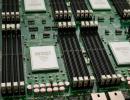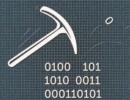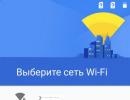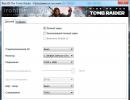Test work in computer science “Modeling and formalization. Lesson Test "Models and Simulation" Questions and assignments
Municipal educational budgetary institution
Lyceum No. 23, Sochi, Krasnodar Territory
Tests by topic:
“Modeling as a method of cognition”,
“Model presentation forms”
in 9th grade
2 options with answers
prepared
computer science and ICT teacher
Ivanykina Olga Yurievna
Sochi
2014
Subject:
Option 1
Surname ____________________
1. A model is the replacement of the object under study with another object that reflects…
all sides of this object
some aspects of this object
essential aspects of this object
insignificant aspects of this object
Answer: 1 -
2. What pairs of objects are in the “object-model” relationship?
computer - data
computer - its functional diagram
computer - program
computer - algorithm
Answer: 2 –
3. “Drawing up a city plan”
appearance;
structure;
behavior.
Answer: 3 –
4. What is the purpose of creating the following model: “sketch of a new computer desk”?
explanation of known facts;
building hypotheses;
forecasting;
management.
Answer: 4 –
5 . What pairs of objects are not in the object-model relationship?
The sun is his drawing;
The sun is its structure;
The sun is his ray;
The sun - its chemical composition.
Answer: 5 —
Subject: "Modeling as a process of cognition"
Option 2
Surname ____________________
1. Modeling is...
the process of making toy copies of objects;
the process of following fashionable trends in life, culture, fashion;
a method of cognition consisting in the creation and study of models.
Answer: 1 –
2. Which pairs of objects are not in the “object-model” relationship?
computer - his drawing;
computer - its functional diagram;
computer - its processor;
computer - its technical description.
Answer: 2 –
3. Which aspect is being modeled in this example: “Drafting a presentation plan”
appearance;
structure;
behavior.
Answer: 3 –
4. What is the purpose of creating the following model: “Lesson Scheduling”?
presentation of material objects;
explanation of known facts;
building hypotheses;
obtaining new knowledge about the objects under study;
forecasting;
management.
Answer: 4 –
5. What pairs of objects are in the “object-model” relationship?
shopping center - a set of goods;
shopping center – opening hours;
shopping center - its layout;
shopping center - list of employees.
Answer: 5 —
Option 1
Surname _____________________________
a) anatomical model
c) drawing
d) diagram
Answer: 1-
a) building layout
b) globe
d) toy car model
Answer: 2-
The recipe for making borscht is...
a) formal model
b) descriptive model
c) figurative form of the model
d) material model
Answer: 3-
Formalization is...
a) the process of bringing the model to a beautiful shape;
b) the process of building models using formal languages;
c) the process of recording a model in natural language.
Answer: 4-
a) technical description of the computer;
b) photo of a computer;
c) computer logic circuit;
d) drawing of a computer.
Answer: 5-
Topic: “Model presentation forms”
Option 2
Surname___________________________
The material model is:
a) formula for calculating the volume of a cube;
b) diagram;
c) paper model of the building;
d) photograph.
Answer: 1-
The information model is:
a) a dummy of a water molecule;
b) a graph of air temperature changes during the month;
c) layout of a computer center;
d) model of a sailboat.
Answer: 2-
The reaction between sulfuric acid (H 2 SO 4) and iron oxide (FeO) is...
a) descriptive model;
b) figurative form of the model;
c) formal model;
d) material model.
Answer: 3-
The city plan is...
a) figurative form of the model;
b) iconic form of the model;
c) descriptive model;
d) formal model.
Answer: 4-
The formal information model is:
a) computer layout;
b) technical description of the computer;
c) drawing of a computer;
d) program.
Answer: 5-
ANSWERS TO TESTS
Subject: "Modeling as a process of cognition"
Option 1 | |||||
Option 2 |
Topic: “Model presentation forms”
Option 1 | |||||
Option 2 |
List of used literature
1. Molodtsov V.A., Ryzhikova N.B. How to pass the exam and centralized testing in computer science with 100 points. - Rostov n/d: Phoenix, 2003.
Option 1.
1. A model is the replacement of the object under study with another object that reflects:
1) All signs of this object;
2) Some signs of this object;
3) essential features of this object;
4) insignificant features of this object.
2. The process of building models is called:
1) Modeling;
2) Design;
3) Experimentation;
4) Design.
3. The information (sign) model is:
1) anatomical model;
2) building layout;
3) ship model;
4) chemical formula.
4. The material model is:
1) aircraft model;
3) drawing;
4) diagram.
1) computer - data;
2) computer - its functional diagram;
3) computer - program;
4) computer - algorithm.
6. How many objects does a system typically consist of?
1) from several;
2) from one;
3) from an infinite number;
4) it is not divisible.
Departure airport | Arrival airport | Departure time | Arrival time |
7. There are daily flights between the four major airports coded DLU, IGT, OPK and QLO. Here is a fragment of the flight schedule between these airports:
The traveler is at DLU airport at midnight (0:00). Determine the earliest time he can be at QLO Airport.
At orienteering competitions, the participant must run from start to finish, overcoming the least number of obstacles (their number on each section of the path is indicated in the figure). What is the least number of obstacles an athlete can overcome?
There lived three young men: Andrey, Bronislav and Boris. One of them is a pharmacist, another is an accountant, and the third is an agronomist. One lives in Bobruisk, the other in Arkhangelsk, the third is an agronomist. It is necessary to find out who lives where and what profession. What is known is that:
1) Boris visits Bobruisk only on short visits, and then very rarely, although all his relatives live in this city.
2) Two of these people have names of professions and cities in which they live that begin with the same letter as their names.
3) The pharmacist’s wife is Boris’s younger sister.
CONTROL PAPER No. 2 ON THE TOPIC: “MODELING AND FORMALIZATION”
Option 2.
1. What is a simplified representation of a real object called?
1) original;
2) prototype;
3) model;
4) system.
2. The result of the formalization process is:
1) descriptive model;
2) mathematical model;
3) graphical model;
4) subject model.
3. The material model is:
1) anatomical model;
2) technical description of the computer;
3) drawing of a functional diagram of a computer;
4) a program in a programming language.
4. The information (sign) model is:
2) children's toy;
3) globe;
4) building layout.
5. Which pair of objects is in the “object - model” relationship?
1) computer - processor
2) Novosibirsk - city
3) slush - runny nose
4) car – its technical description.
6. Which model is static (describing the state of an object)?
1) formula for uniformly accelerated motion;
2) formula of a chemical reaction;
3) formula of a chemical compound;
4) Newton's second law.
7. There are daily flights between four major airports, designated by the codes VOK, EDT, LAA and SAK. Here is a fragment of the flight schedule between these airports:
Departure airport | Arrival airport | Departure time | Arrival time |
The traveler is at the airport at VOK at midnight (0:00). Determine the earliest time he can be at the airport. S.A.K.
8. The transportation cost table is structured as follows: the numbers at the intersections of the rows and columns of the tables indicate the cost of travel between the corresponding neighboring stations. If the intersection of a row and a column is empty, then the stations are not adjacent. Find the path that minimizes the cost of travel from A to E. What is this minimum cost? Write it down as an answer. The cost of travel along the route is the sum of the costs of travel between the corresponding neighboring stations.
At orienteering competitions, the participant must run from start to finish, overcoming the least number of obstacles (their number on each section of the path is indicated in the figure). What is the least number of obstacles an athlete can overcome?
10. Solve a logic problem using a table.
The three daughters of the writer Doris Kay - Judy, Iris and Linda - are also very talented. They gained fame in various forms of art - singing, ballet and cinema. They all live in different cities, so Doris often calls them in Paris, Rome and Chicago. It is known that:
Judy does not live in Paris, and Linda does not live in Rome; the Parisian does not act in films; the one who lives in Rome is a singer; Linda is indifferent to ballet.
Where does Iris live and what is her profession?
Option 1.
Question | |||||||||
Answer |
Pharmacist | Accountant | Agronomist | Bobruisk | Arkhangelsk | Belgorod |
|
Andrey | ||||||
Bronislaw | ||||||
Boris |
Option 2.
Question | |||||||||
Answer |
Paris | Chicago | singing | ballet | movie |
||
Judy | ||||||
Iris | ||||||
Linda |
Iris lives in Paris and practices ballet.
Municipal educational budgetary institution
Lyceum No. 23, Sochi, Krasnodar Territory
Tests by topic:
"Modeling as a method of cognition",
"Model presentation forms"
in 9th grade
2 options with answers
prepared
computer science and ICT teacher
Ivanykina Olga Yurievna
Sochi
2014
Subject:
Option 1
Surname ____________________
1. A model is the replacement of the object under study with another object that reflects…
- all sides of a given object some sides of a given object essential sides of a given object inessential sides of a given object
Answer: 1 -
2. What pairs of objects are in the “object-model” relationship?
- computer - data computer - its functional diagram computer - program computer - algorithm
Answer: 2 –
3. “Drawing up a city plan”
Answer: 3 –
4. What is the purpose of creating the following model: “sketch of a new computer desk”?
Answer: 4 –
5 . What pairs of objects are not in the object-model relationship?
- The sun is his drawing; The sun is its structure; The sun is his ray; The sun - its chemical composition.
Answer: 5 -
Subject: "Modeling as a process of cognition"
Option 2
Surname ____________________
1. Modeling is...
- the process of making toy copies of objects; the process of following fashionable trends in life, culture, fashion; a method of cognition consisting in the creation and study of models.
Answer: 1 –
2. Which pairs of objects are not in the “object-model” relationship?
- computer - his drawing; computer - its functional diagram; computer - its processor; computer - its technical description.
Answer: 2 –
3. Which aspect is being modeled in this example: “Drafting a presentation plan”
- appearance; structure; behavior.
Answer: 3 –
4. What is the purpose of creating the following model: “Lesson Scheduling”?
- presentation of material objects; explanation of known facts; building hypotheses; obtaining new knowledge about the objects under study; forecasting; management.
Answer: 4 –
5. What pairs of objects are in the “object-model” relationship?
- shopping center - a set of goods; shopping center – opening hours; shopping center - its layout; shopping center - list of employees.
Answer: 5 -
Option 1
Surname _____________________________
a) anatomical model
c) drawing
d) diagram
Answer: 1-
a) building layout
b) globe
d) toy car model
Answer: 2-
The recipe for making borscht is...
a) formal model
b) descriptive model
c) figurative form of the model
d) material model
Answer: 3-
Formalization is...
a) the process of bringing the model to a beautiful shape;
b) the process of building models using formal languages;
c) the process of recording a model in natural language.
Answer: 4-
a) technical description of the computer;
b) photo of a computer;
c) computer logic circuit;
d) drawing of a computer.
Answer: 5-
Topic: “Model presentation forms”
Option 2
Surname___________________________
The material model is:
a) formula for calculating the volume of a cube;
b) diagram;
c) paper model of the building;
d) photograph.
Answer: 1-
The information model is:
a) a dummy of a water molecule;
b) a graph of air temperature changes during the month;
c) layout of a computer center;
d) model of a sailboat.
Answer: 2-
The reaction between sulfuric acid (H 2 SO 4) and iron oxide (FeO) is...
a) descriptive model;
b) figurative form of the model;
c) formal model;
d) material model.
Answer: 3-
The city plan is...
a) figurative form of the model;
b) iconic form of the model;
c) descriptive model;
d) formal model.
Answer: 4-
The formal information model is:
a) computer layout;
b) technical description of the computer;
c) drawing of a computer;
d) program.
Answer: 5-
ANSWERS TO TESTS
Subject: "Modeling as a process of cognition"
Topic: “Model presentation forms”
List of used literature
1. Molodtsov V.A., Ryzhikova N.B. How to pass the exam and centralized testing in computer science with 100 points. - Rostov n/d: Phoenix, 2003.
1 option
a) computer – data;
c) computer – program;
d) computer - algorithm;
2.
3. Databases are:
d) a set of data organized according to certain rules;
a) without modules;
b) without requests;
c) without reports;
d) without tables;
c) storing database data;
6.
a) hierarchical;
b) network;
c) tabular;
d) logical;
7.
a) MS Word;
8. An operating system is...
a) a program that provides database management;
b) antivirus program;
c) a program that controls the operation of a computer;
d) programming system;
9. Can a computer virus be present on a blank floppy disk (no files on the floppy disk)?
a) no;
b) yes, in the data area;
c) yes, in the catalog area;
d) yes, in the boot sector of the floppy disk;
10.
a) low temperature;
d) shocks during installation;
11. In roulette, the total number of holes is 32. How much information do we receive in a visual message about the ball stopping in one of the holes?
d) 1 bit;
12. What form will the formula containing absolute and relative links written in cell C1 take after it is copied to cell C2?
a) =$A$1*B2;
13. The browser is...
a) a network virus;
14. A modem is...
a) mail program;b) network protocol;
c) Internet server;
d) technical device;
15.
a) 1 minute;c) 1 second;
16.
a) HTTP;c) TCP;
17.
a) IP address;b) Web server;
c) home web page;
No
condition 1
episode 1
episode 2
episode 3
d) domain name;
18. What type of model is shown in the picture?
a) graphical model;
b) algorithmic model;
c) verbal;
d) descriptive;
19.
20.
a) *.txt;b) *.htm;
c) *.doc;
d) *.exe;
21.
a) hierarchical;
b) tabular;
c) algorithmic;
d) network;
22. What is formalization?
d) description of information models using natural languages;
23. The World Wide Web is...
d) a means of accessing Internet information resources;
24.
a) controller;
c) processor;
d) adapter;
25. The combination of computers and local networks located at a remote distance for the common use of world information resources is called...
a) local network;
b) global network;
c) corporate network;
d) regional network;
26. A computer that provides its resources for use by other computers when working together is called:
a) adapter;
b) switch;
c) server;
d) client-server;
27.
a) from RAM;
b) from ROM;
c) from a magnetic disk;
d) from a CD;
28. How is the decimal number 5 written in the binary number system?
b) 110;
d)100;
29.Hypertext is...
a) very large text;
b) structured text in which transitions can be made using selected tags;
c) text typed on a computer;
d) text that uses a large font;
30.
a) projection panel;
d) plotter;
Final test in computer science 11th grade
Option 2
1. What type of information model does not exist?
a) hierarchical;
b) tabular;
c) algorithmic;
d) network;
2. When the computer is turned off, the information is erased:
a) from RAM;
b) from ROM;
c) from a magnetic disk;
d) from a CD;
3. In order to preserve information, hard magnetic disks must be protected from...
a) low temperature;
b) changes in atmospheric pressure;
d) shocks during installation;
4. A modem is...
a) mail program;b) network protocol;
c) Internet server;
d) technical device;
5. The unification of computers and local networks located at a remote distance for the common use of world information resources is called...
a) local network;
b) global network;
c) corporate network;
d) regional network;
6. What is formalization?
a) the process of constructing information models using formal languages;
b) a method of cognition, consisting in the creation and study of formal models;
c) visualization of the process of researching formal models;
d) description of information models using natural languages;
7. The World Wide Web is...
a) a global computer network that unites local, regional, corporate networks and millions of computers;
b) tens of millions of Internet Web servers containing Web pages that use hypertext technology;
c) a set of universal resource locator, including the document access protocol, domain names and IP address;
d) a means of accessing Internet information resources;
8. Hyperlinks on a Web page can provide a link...
a) only within this web page;b) only on the web pages of this server;
c) to any web page of this region;
d) to any web page of any Internet server;
9.A device that converts analog signals into digital signals and vice versa is called:
a) controller;
c) processor;
d) adapter;
10. Web pages have the format (extension)...
a) *.txt;b) *.htm;
c) *.doc;
d) *.exe;
11. What pairs of objects are in the “object - model” relationship?
a) computer – data;
b) computer - its functional diagram;
c) computer – program;
d) computer - algorithm;
12. Databases are:
a) an interface that supports data filling and manipulation;
b) a set of programs for storing and processing large amounts of information;
c) a certain set of information;
d) a set of data organized according to certain rules;
13. Database tables are intended for:
a) automatic execution of a group of commands;
b) performing complex program actions;
c) storing database data;
d) selection and processing of database data;
14. What software tools help you create tabular models?
a) MS Word;
15. A multimedia computer must include...
a) projection panel;
b) CD-ROM drive and sound card;
d) plotter;
16. Without which objects a database cannot exist?
a) without modules;
b) without requests;
c) without reports;
d) without tables;
17. Which of the following definitions of the concept “model” are correct?
a) a model is some kind of auxiliary tool, an object that in a certain situation replaces another object;
b) a model is a new object that reflects some aspects of the object or phenomenon being studied that are significant from the point of view of the purpose of modeling;
c) a model is a physical or information analogue of an object, the functioning of which – according to certain parameters – is similar to the functioning of a real object;
d) a model of some object is another object (real, symbolic or imaginary), different from the original one, which has properties essential for modeling purposes and, within the framework of these purposes, completely replaces the original object;
18. What type of information model is a computer file system?
a) hierarchical;
b) network;
c) tabular;
d) logical;
19. The material model is...
a) anatomical model;
b) map;
c) drawing;
d) diagram;
20. The full path to the file is C:\DOC\PROBA.TXT . What is the name of the directory where the PROBA.TXT file is located?
b) DOC;
c) C:\DOC\PROBA.TXT;
d) TXT;
21. The result of the calculations in cell C1 will be:
a) 100;
b) 50;
c) 200;
d) 150;

22. Internet servers containing file archives allow...
a) download the necessary files;
b) receive email;
c) participate in teleconferences;
d) conduct video conferences;
23. The browser is...
a) a network virus;
b) a web page viewer;
c) Web page markup language;
d) programming language translator;
24. A computer connected to the Internet must have...
a) IP address;b) Web server;
c) home web page;
d) domain name;
25. In roulette, the total number of holes is 32. How much information do we receive in the visual message about the ball stopping in one of the holes?
d) 1 bit;
26. The processor processes information...
a) in the decimal number system;
b) in binary code;
c) in BASIC language;
d) in text form;
27. A modem transmitting information at 28,800 bps can transmit two pages of text (3,600 bytes) within...
a) 1 minute;c) 1 second;
28. A computer that provides its resources for use by other computers when working together is called:
a) adapter;
b) switch;
c) server;
d) client-server;
29. Which protocol is the basic one on the Internet?
a) HTTP;c) TCP;
30. The information (sign) model is...
a) anatomical model;
b) building layout;
c) model of the ship;
d) formula;
Final test in computer science
Full name___________________________________________________________class____________option_______________________
|
1 |
2 |
3 |
4 |
5 |
6 |
7 |
8 |
9 |
10 |
11 |
12 |
13 |
14 |
15 |
16 |
17 |
18 |
19 |
20 |
21 |
22 |
23 |
24 |
25 |
26 |
27 |
28 |
29 |
30 |
|
|
A | ||||||||||||||||||||||||||||||
|
b | ||||||||||||||||||||||||||||||
|
V | ||||||||||||||||||||||||||||||
|
G |
Test on the topic "Modeling and formalization"
1. What is an object attribute?
Representation of a real world object using a certain set of its characteristics that are essential for solving a given information problem.
An abstraction of real-world objects that share common characteristics and behavior.
The relationship between an object and its characteristics.
Each individual characteristic common to all possible instances
2. The choice of model type depends on:
The physical nature of the object.
Purpose of the object.
Objectives of the object research.
Information entity of the object.
3. What is an object information model?
A material or mentally imagined object that replaces the original object during the research process while preserving the most essential properties important for this research.
A formalized description of an object in the form of text in some coding language containing all the necessary information about the object.
A software tool that implements a mathematical model.
Description of the attributes of objects that are essential for the task under consideration and the connections between them.
4. Specify the classification of models in the narrow sense of the word:
Natural, abstract, verbal.
Abstract, mathematical, informational.
Mathematical, computer, information.
Verbal, mathematical, informational
5. The purpose of creating an information model is:
Processing data about a real-world object, taking into account the relationship between objects.
Complicating the model by taking into account additional factors that were previously informed.
Study of objects based on computer experimentation with their mathematical models.
Representation of an object in the form of text in some artificial language accessible to computer processing.
6. Which model is static (describing the state of an object)?
Formula for uniformly accelerated motion
Chemical reaction formula
Chemical formula
Newton's second law.
7. Formalization is
The stage of transition from a meaningful description of the connections between the selected features of an object to a description using some coding language.
Replacing a real object with a sign or a set of signs.
Transition from fuzzy problems arising in reality to formal information models.
Identification of essential information about the object.
8. Information technology is called
A process determined by a set of means and methods of processing, manufacturing, changing the state, properties, and shape of a material.
Changing the initial state of an object.
A process that uses a set of means and methods for processing and transmitting primary information of new quality about the state of an object, process or phenomenon.
A set of specific actions aimed at achieving a set goal.
9. The material model is:
1. Anatomical model;
2. Technical description of the computer;
3. Drawing of a functional diagram of a computer;
4. Program in a programming language.
10. What is a computer information model?
Representation of an object in the form of a test in some artificial language accessible to computer processing.
A set of information characterizing the properties and state of an object, as well as its relationship with the outside world.
A mental or spoken model implemented on a computer.
A research method related to computing.
11. A computer experiment consists of a sequence of stages:
Choosing a numerical method - developing an algorithm - executing a program on a computer.
Construction of a mathematical model - selection of a numerical method - development of an algorithm - execution of the program on a computer, analysis of the solution.
Model development - algorithm development - implementation of the algorithm in the form of a software tool.
Construction of a mathematical model - development of an algorithm - execution of the program on a computer, analysis of the solution.
№ question
№ answer





